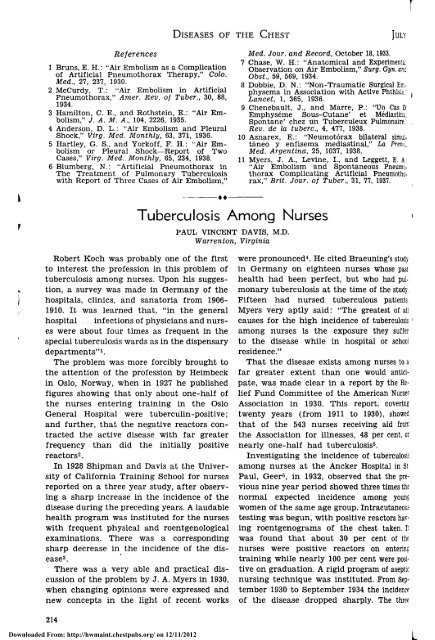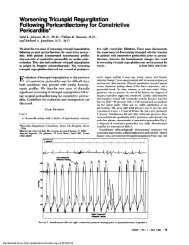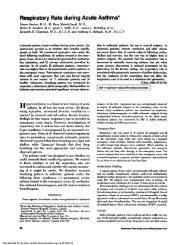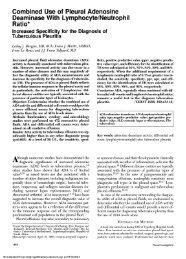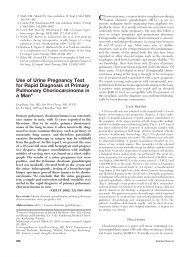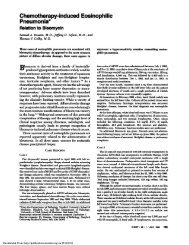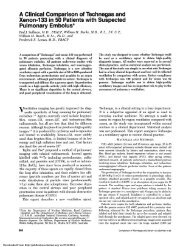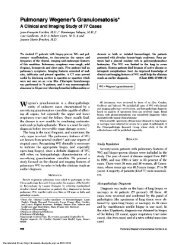Cerebral Air Embolism, Subcutaneous Emphysema, and ...
Cerebral Air Embolism, Subcutaneous Emphysema, and ...
Cerebral Air Embolism, Subcutaneous Emphysema, and ...
You also want an ePaper? Increase the reach of your titles
YUMPU automatically turns print PDFs into web optimized ePapers that Google loves.
References<br />
1 Bruns, E. H.: "<strong>Air</strong> <strong>Embolism</strong> as a Complication<br />
of Artificial Pneumothorax Therapy," Colo.<br />
Med., 27, 237, 1930.<br />
2 McCurdy, T.: "<strong>Air</strong> <strong>Embolism</strong> in Artificial<br />
Pneumothorax," Amer. Rev. of Tuber., 30, 88,<br />
1934.<br />
3 Hamilton, C. E., <strong>and</strong> Rothstein, E.: "<strong>Air</strong> <strong>Embolism</strong>,"<br />
J. A. M. A., 104, 2226, 1935.<br />
4 Anderson, D. L.: "<strong>Air</strong> <strong>Embolism</strong> <strong>and</strong> Pleural<br />
Shock," Virg. Med. Monthly, 63, 371, 1936.<br />
5 Hartley, G. S., <strong>and</strong> Yorkoff, F. H.: "<strong>Air</strong> <strong>Embolism</strong><br />
or Pleural Shock—Report of Two<br />
Cases," Virg. Med. Monthly, 65, 234, 1938.<br />
6 Blumberg, N.: "Artificial Pneumothorax in<br />
The Treatment of Pulmonary Tuberculosis<br />
with Report of Three Cases of <strong>Air</strong> <strong>Embolism</strong>,"<br />
Robert Koch was probably one of the first<br />
to interest the profession in this problem of<br />
tuberculosis among nurses. Upon his suggestion,<br />
a survey was made in Germany of the<br />
hospitals, clinics, <strong>and</strong> sanatoria from 1906-<br />
1910. It was learned that, "in the general<br />
hospital . . infections of physicians <strong>and</strong> nurses<br />
were about four times as frequent in the<br />
special tuberculosis wards as in the dispensary<br />
departments" 1 .<br />
The problem was more forcibly brought to<br />
the attention of the profession by Heimbeck<br />
in Oslo, Norway, when in 1927 he published<br />
figures showing that only about one-half of<br />
the nurses entering training in the Oslo<br />
General Hospital were tuberculin-positive;<br />
<strong>and</strong> further, that the negative reactors contracted<br />
the active disease with far greater<br />
frequency than did the initially positive<br />
reactors 2 .<br />
In 1928 Shipman <strong>and</strong> Davis at the University<br />
of California Training School for nurses<br />
reported on a three year study, after observing<br />
a sharp increase in the incidence of the<br />
disease during the preceding years. A laudable<br />
health program was instituted for the nurses<br />
with frequent physical <strong>and</strong> roentgenological<br />
examinations. There was a corresponding<br />
sharp decrease in the incidence of the disease<br />
3 .<br />
There was a very able <strong>and</strong> practical discussion<br />
of the problem by J. A. Myers in 1930,<br />
when changing opinions were expressed <strong>and</strong><br />
new concepts in the light of recent works<br />
214<br />
Downloaded From: http://hwmaint.chestpubs.org/ on 12/11/2012<br />
DISEASES OF THE CHEST JULY<br />
Med. Jour, <strong>and</strong> Record, October 18,1933.<br />
7 Chase, W. H.: "Anatomical <strong>and</strong> Experimental<br />
Observation on <strong>Air</strong> <strong>Embolism</strong>," Surg. Gyn. anc<br />
Obst., 59, 569, 1934.<br />
8 Dobbie, D. N.: "Non-Traumatic Surgical <strong>Emphysema</strong><br />
in Association with Active Phthisis.<br />
Lancet, 1, 365, 1936.<br />
9 Chenebault, J., <strong>and</strong> Marre, P.: "Un Cas D<br />
Emphyseme Sous-Cutane' et Mediastina;<br />
Spontane' chez un Tuberculeux Pulmonaire.<br />
Rev. de la tuberc., 4, 477, 1938.<br />
10 Aznarex, E.: "Neumotorax bilateral simultaneo<br />
y enfisema mediastinal," La Prem<br />
Med. Argentina, 25, 1037, 1938.<br />
11 Myers, J. A., Levine, I., <strong>and</strong> Leggett, E. A<br />
"<strong>Air</strong> <strong>Embolism</strong> <strong>and</strong> Spontaneous Pneumothorax<br />
Complicating Artificial Pneumothorax,"<br />
Brit. Jour, of Tuber., 31, 77, 1937.<br />
Tuberculosis Among Nurses<br />
PAUL VINCENT DAVIS, M.D.<br />
Warrenton, Virginia<br />
were pronounced 4 . He cited Braeuning's study<br />
in Germany on eighteen. nurses whose past<br />
health had been perfect, but who had pulmonary<br />
tuberculosis at the time of the study.<br />
Fifteen had nursed tuberculous patients<br />
Myers very aptly said: "The greatest of all<br />
causes for the high incidence of tuberculosis<br />
among nurses is the exposure they suffer<br />
to the disease while in hospital or school<br />
residence."<br />
That the disease exists among nurses to a<br />
far greater extent than one would anticipate,<br />
was made clear in a report by the Relief<br />
Fund Committee of the American Nurses<br />
Association in 1930. This report, covering<br />
twenty years (from 1911 to 1930), showed<br />
that of the 543 nurses receiving aid froir.<br />
the Association for illnesses, 48 per cent, or<br />
nearly one-half had tuberculosis 5 .<br />
Investigating the incidence of tuberculosis<br />
among nurses at the Ancker Hospital in St.<br />
Paul, Geer 6 , in 1932, observed that the previous<br />
nine year period showed three times the<br />
normal expected incidence among youn?<br />
women of the same age group. Intracutaneou. ;<br />
testing was begun, with positive reactors having<br />
roentgenograms of the chest taken. I:<br />
was found that about 30 per cent of the<br />
nurses were positive reactors on entering<br />
training while nearly 100 per cent were positive<br />
on graduation. A rigid program of aseptic<br />
nursing technique was instituted. From September<br />
1930 to September 1934 the incidence<br />
of the disease dropped sharply. The three


